|
|
|
List of BC Adventure Advertisers Site Info
Advertise With UsAwards About Us Contact Us  Kayak with Killer Whales Free Vacation Guides
BC Vacation GuidesCoastal Vacations Thompson Okanagan EcoTourism Fishing Vacations Guest Ranch Guide Romantic Getaways Wilderness Vacations Winter Vacations The Rockies Guide 
Coastal Spirits Expeditions Login |
Even average size fish in the Skeena region are considered trophies when compared to catches taken elsewhere. Steelhead weigh more that twenty pound and chinook over fifty pounders are not uncommon. Local biologists have also netted several world-record size chum salmon as well as chinook in excess of one hundred pounds. Sheltered amidst the coastal mountain range of the Canadian Rockies, Terrace is surrounded by fishing opportunities. Discover ancient forests, majestic waterfalls, glaciers, volcanic boulder fields, fossil beds, not spring, eagles, mountain goats and the elusive Kermodei bear.
Summer
FallIn September, summer-run steelheading is outstanding and fly-fishing conditions are usually ideal. In addition, the main runs of northern hooked-jaw coho begin filling most rivers. These hard fighters can average 15-pounds and fish over 20-pounds are not uncommon. Dolly Varden are also plentiful. In October and November, fly-fishing for steelhead and coho is in full swing. Float fishing and spinning is also effective - there's lots of fish and they're aggressive. WinterIn December, January and February, the focus narrows to steelhead only. There are three ice-free rivers in the Terrace area that hold wintering steelhead. In cold low water conditions, a subtle approach often leads to excellent results. Fly-fishing, spinning and float fishing are the most popular methods. THE SKEENA, For World Record Chinook The Skeena River is "where to be" when angling for world record Chinook Salmon! While the nearby Kitimat River also has a large run of Chinook, on average, they are smaller fish. Fishery employees have found carcasses of Chinook spawned out along the banks of the Skeena system that weighed more than 107-pounds!
The boat launch known as "Fishermen's Park" is only a five-minute drive from downtown Terrace and it's usually full of vehicles and empty jet-boat trailers. Summer is an exciting time of year! Several years ago, a world record Chinook (weighing 92 ½ - pounds) was landed by Mr. Heinz Wickman of Terrace, from the Skeena River near the mouth of the Kalum River. This fish was caught with a Lure Jensen Crocodile lure. Our lodge record Chinook weighed 83-pounds. Ninety per cent of the Chinook in the Skeena River are wild fish. Some hatchery Chinook do exist, but most are wild fish. The Kitimat river probably has more hatchery Chinook because of the $10 million fish hatchery. My personal fishing diary goes back some 15 years fishing the Skeena River. My log pays special attention to fish over 70-pounds. The ultimate challenge in river sportfishing is to try and land one of these "giants". It's especially difficult because of the fast-flowing, six-mile-per-hour river current. While angling for Chinook you may also hook "fresh" summer-run Steelhead. These fish are in the system migrating further upstream to distant tributaries for spawning. The silver chrome fish will surely give you a tackle-straining experience. I believe more could be hooked if it weren't for Chinook chasing and spooking them as they defend their "reds."
My favorite fishing method is "pulling-plugs." I like to use the big magnum Hot Shots with number seven Gamakatsu hooks, razor sharp. I use Ambassador 7000 reels filled to capacity with Ande 30-pound test line. The bottom line: to have a very successful fishing trip, you need: 1) A good run of fish. 2) Proper timing of the runs. 3) Good water and weather conditions. Unfortunately, we cannot control the water conditions, but with so many watersheds available, quality angling can always be found. OCT0BER dreamingThis is a fantastic time to angle for both steelhead and coho salmon plus resident Cutthroat, Rainbow Trout and Dolly Varden Char in northwest British Columbia, Canada. Let's talk about the Coho salmon first.
The Skeena river and its many tributaries are fortunate to have many large runs of these "silver" beauties. The first migrating Coho are of average size but later, in October, the "larger" Coho start to appear. We call these larger fish "northerns" because, not only is their average weight higher, they also have the distinctive large "hooked" nose that we commonly refer to as the "northern nose". Even the females have the hooked nose although not as prominent as the male. The regular Coho average between 6 and 12-pounds but the "northerns" average between 12 and 20-pounds with the odd fish weighing more than 25-pounds. Northwest Fishing Guides lodge record Coho weighed an amazing 27-pounds. This fish was landed by a repeat guest, Mr. Jack Baikowitz, in middle October 1995 in the Kasiks river. Mr. Baikowitz now wants to be called "Mr. Coho" from now on. A 20 x 30 inch poster photo of this record fish hangs on the wall at the lodge. Yo Ho!...that's the "battle cry" in the fall that most of us yell when the Coho start coming. This is a very exciting time of year. The Coho arrive into the Skeena system at the beginning of August. The smaller Coho enter the river first as they have the furthest to travel. The "BIG" Chinook Salmon runs are coming to an end and all but over. Even though there are still Chinook Salmon in the rivers, most are getting too dark and usually are left alone to spawn, preferring to angle for brighter fish. If you talking "table fare"...why would anyone want to kill a dark fish? Everyone's attention turn to the bright silver Coho Salmon. A good angler can hook many more Coho than Chinook. Nature dictated that the smaller fish will be more plentiful. What a great way to end the salmon season...with "blow-out" Coho fishing. This is the most "anti" combat angling area you can find anywhere, especially in the fall. Many time when fishing for Coho you will be the only person in the pool. I am referring to the isolated coastal rivers, only accessible by jet-boat, near Terrace. My favorite river is the Kasiks. The jet-boat ride up this river is fantastic. For 8 miles you wind your way upstream through mountain flanks that touches the river on both sides. Slate gray rock faces confined the river to a narrow slot. A thousand tiny waterfall skittered down the rock faces plunging into the small river. Even though the runs are strong in our area, it is still wise to practice conservation. We want these Coho here forever. Please learn the correct way to catch and release and teach your friends. It will work for Coho as well as it has been proven to work for Steelhead. Do not stress a fish by playing it too long (usually caused by using too light a line) or dragging it in too quickly, so that it beats its head on the rocks. Keep the fish off the rocks and in deep water. The angler should be wearing chest waders or at least hip waders so he can accomplish this. Use "barbless" hooks or hooks that have small barbs, such as Gamakatsu. To assist in landing a fish use a glove or sock to grip the tail. For a large fish use a glove on both hands. Do not pick them up only by the tail and lift them high into the air as this puts too much stress on their backbone. Keep the fish horizontal by supporting the belly with the other hand. Do not use a landing net as the mesh can cause excessive scale loss and split fins. Try and keep their head in the water as much as possible, then hold them up for a quick "kiss" and photo then let them go. Take the hook out gently. If you do this correctly you will not need the pliers. If the fish has the strength to wiggle its tail, let it "kick" out of your hand and swim, do not hold it back. Celebrate! If you keep a fish to eat, make sure that it is silver and fresh. Do not keep a dark fish as it is probably too near to spawning and the meat will not make good table fare.
I love using the flyrod in a weight 8 or 9 or a light spinning rod and reel filled with 12-pound test and a jig as terminal tackle. The jig works well in very clean water, calm or slow moving deep pools where you know fish are holding and you cannot see them, except for the odd "roll" or "rise" now and then. If you find a pool or run where you can see the fish because the water is very clear and not that deep, your terminal tackle choice should be a lure such as the Lure Jensen Crocodile or a light thin spoon weighed if needed, with split shot. Use something thin that glides through the water and is designed to represent small fish that the Coho think are a threat to their spawning "reds" or area. Sometimes a spinner such as the Blue Fox #4 or 5 is the correct bait. The spinner blades cause it to be retrieved slowly, letting the fish have a good look at it and thereby making a decision to strike. With other terminal tackle, such as thin lures most folks retrieve them too quickly. Slow down your retrieve. I know this will cause you to lose a few lures but you have to be down deep and your lure has to be moving slow enough to give the fish a chance to react. Always keep you hook sharp. After awhile, not matter what your using or how you present it, the fish will spook or develop "lock jaw" and stop biting. In that case, you are advised to find another "fresh" or un-spooked pool. Float fishing or bottom bouncing works the best when the water is higher, the fish are not spooked and the current is moving at the correct speed. Many types of terminal tackle will work when float fishing but I think the best bait is "dime size" egg bags fished on number 2 hooks. October is "PRIME TIME" for "wild" B.C. Steelhead in our area. They are referred to as wild because there are no hatchery steelhead in the whole Skeena river and it's tributaries. Both conventional and fly tackle users will be in "heaven". The main rivers we fish are the Skeena, Copper and Meziadin. We also fish in the Meziadin Lake. At this time of year the lake is full of spawning Sockeye Salmon, consequently the fishing for Dolly Varden Char is fantastic. These are big Dolly's that weigh up to 6-pounds and Rainbows to 5-pounds. At the end of the lake, where the lake turns into river is the best spot in the world for steelhead and Coho fishing. The river is jammed with fish. No matter how bad the weather, this river remains fishable all the time. Another river in our area, called the Copper, excellent for Steelhead at this time. Care must be taken when wading this river because the bottom is strewn with large and small boulders and one can trip over them if not careful. If the water is very clean, the flyrod will hook many fish. Convention tackle users will have no trouble hooking up to six or more fish per day.
Catch & Release formula…Chinook: girth squared x length x 1.53 divided by 1000. Steelhead: girth squared x length x 1.33 divided by 1000 (inches) Story by Noel Gyger |
 Follow Us On Facebook
BC Rivers
Blackwater RiverBulkley-Morice River Chilko River Cowichan River Dean River Elk River Fraser River - Lower Section Kispiox River Skagit River Skeena River Squamish River St. Mary River Stellako River Thompson River Vedder-Chilliwack River Game Fish
Salmon WatchingSalmon and Creeks Sea-Run Cutthroat River Fly Tactics
Dual Purpose EquipmentSept' Fishing for Salmon Steelheading
ASCENSIONApril Rivers Campbell River Steelhead Fly Fishing Steelhead Gold River Steelhead History of Steelheading New Rivers Part 1 New Rivers Part 2 Playing a Trophy Fish Steelhead Survival Steelhead Trout Steelheading Truisms Tips for Steelheaders Vancr Isle Steelhead Wading the River Techniques
Fabulous Fall ChinookFishing with Floats Fly Casting Releasing Large Fish The Sturgeon of the Fraser River Tough Knots for Big Fish Walking the Dogs |
|||
|
|||||
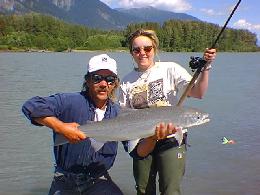 Skeena
River, BC
Skeena
River, BC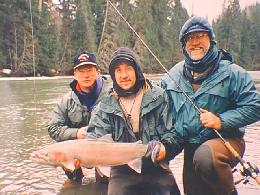 In March, steelheading
is in full swing. Water levels are low and weather conditions
are improving. On a warm day it can almost feel like summer. By
April, although there is always the chance of wet snow or rain,
weather conditions are generally favorable. Fresh runs of steelhead
make their way up rivers and mingle with winter populations. These
aggressive fish offer explosive action, whether it be fly-fishing
from shore or hot-shotting by drift boat. Also, giant chinook
salmon begin making their way up the Skeena and enter the Kalum
River. In May, the chinook can be found throughout the Skeena
and Kalum, a Skeena tributary, where the fishing is often outstanding;
steelhead can still be caught, although their numbers decline
once spawning is over.
In March, steelheading
is in full swing. Water levels are low and weather conditions
are improving. On a warm day it can almost feel like summer. By
April, although there is always the chance of wet snow or rain,
weather conditions are generally favorable. Fresh runs of steelhead
make their way up rivers and mingle with winter populations. These
aggressive fish offer explosive action, whether it be fly-fishing
from shore or hot-shotting by drift boat. Also, giant chinook
salmon begin making their way up the Skeena and enter the Kalum
River. In May, the chinook can be found throughout the Skeena
and Kalum, a Skeena tributary, where the fishing is often outstanding;
steelhead can still be caught, although their numbers decline
once spawning is over.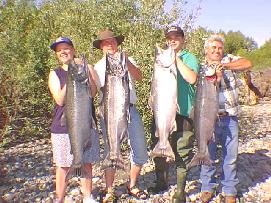 In June, spring run-off
is at its maximum on the main Skeena, so high murky water leads
us to focus on other productive Skeena tributaries. By mid-June,
rivers such as
the Kitimat are full of silver-fresh chinook, and ocean fish are
always an option that can enhance the total catch. July is prime
time for targeting kings everywhere, but on the main Skeena, where
the largest salmon spawn, the most memorable battles await you…In
addition, summer-run steelhead begin their long migration upstream;
these radiant fish can reach up to 20 or 30-pounds and in warm
water, are especially spectacular fighters. In August, the chinook
season begins to wind down in the main rivers as their spawning
period approaches. In some tributaries, catching silver fish is
still possible, but we tend to focus more attentively on the fresh
runs of the steelhead and coho entering the Skeena.
In June, spring run-off
is at its maximum on the main Skeena, so high murky water leads
us to focus on other productive Skeena tributaries. By mid-June,
rivers such as
the Kitimat are full of silver-fresh chinook, and ocean fish are
always an option that can enhance the total catch. July is prime
time for targeting kings everywhere, but on the main Skeena, where
the largest salmon spawn, the most memorable battles await you…In
addition, summer-run steelhead begin their long migration upstream;
these radiant fish can reach up to 20 or 30-pounds and in warm
water, are especially spectacular fighters. In August, the chinook
season begins to wind down in the main rivers as their spawning
period approaches. In some tributaries, catching silver fish is
still possible, but we tend to focus more attentively on the fresh
runs of the steelhead and coho entering the Skeena. 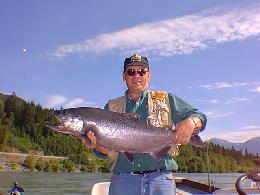 Anglers from around the
world come to Terrace and the Skeena River to angle for these
famous giants. It's approximately a one hour flight from Vancouver,
B.C. by modern jet aircraft. The best time to fish is the whole
month of July and the first week of August. The days are long
with many hours to fish and warm summer temperature of plus 27
degrees Celsius. The best fishing results can be obtained when
the water is clean. Around the Cottonwood area near the mouth
of the Kalum River exceptionally large fish can be seen rolling
all day. This is an incredible sight and it really gets my adrenaline
flowing.
Anglers from around the
world come to Terrace and the Skeena River to angle for these
famous giants. It's approximately a one hour flight from Vancouver,
B.C. by modern jet aircraft. The best time to fish is the whole
month of July and the first week of August. The days are long
with many hours to fish and warm summer temperature of plus 27
degrees Celsius. The best fishing results can be obtained when
the water is clean. Around the Cottonwood area near the mouth
of the Kalum River exceptionally large fish can be seen rolling
all day. This is an incredible sight and it really gets my adrenaline
flowing. The preferred method of angling from the
shore is "plunking" or "still-fishing" with
large Spin and Glow size #00, (double ott) number six or seven
hooks and eight oz. Pyramid lead weights. Some folks like to add
salmon eggs to the hook but I don't think this is necessary. This
is all rigged with a triple swivel. Make sure your fishing rod
is stout enough and well secured in a good rod holder. (I've seen
many broken rods and rods that were jerked into the river by strong
fish.) Put a small bell on the tip of your fishing rod and wait
for the bite! You can also bottom bounce, use a lure or try fly-fishing.
Terrace goes all out to make sport fishermen from out of town
feel welcome. Terrace has many hotels, motels and camping sites,
all located near the fishing grounds. There are several well-stocked
tackle stores to serve you.
The preferred method of angling from the
shore is "plunking" or "still-fishing" with
large Spin and Glow size #00, (double ott) number six or seven
hooks and eight oz. Pyramid lead weights. Some folks like to add
salmon eggs to the hook but I don't think this is necessary. This
is all rigged with a triple swivel. Make sure your fishing rod
is stout enough and well secured in a good rod holder. (I've seen
many broken rods and rods that were jerked into the river by strong
fish.) Put a small bell on the tip of your fishing rod and wait
for the bite! You can also bottom bounce, use a lure or try fly-fishing.
Terrace goes all out to make sport fishermen from out of town
feel welcome. Terrace has many hotels, motels and camping sites,
all located near the fishing grounds. There are several well-stocked
tackle stores to serve you.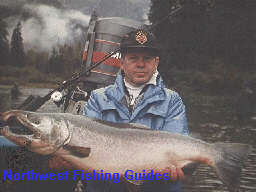 You too can make this
dream a reality if you come here to angle for these beautiful
salmon. When hooked they jump, roll and tumble, wrapping themselves
up in your line, like a pretty package. The rolling and tumbling
is a Coho characteristic! The Americans know them as "silvers"....but
we call them "Yo Ho"...the Coho!.
You too can make this
dream a reality if you come here to angle for these beautiful
salmon. When hooked they jump, roll and tumble, wrapping themselves
up in your line, like a pretty package. The rolling and tumbling
is a Coho characteristic! The Americans know them as "silvers"....but
we call them "Yo Ho"...the Coho!. 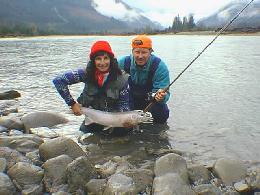 One basic rule applies
when fishing for Coho: if you can't see them rolling, don't fish.
Coho like just about any terminal tackle that is properly presented.
Presentation is everything. And to have some fun with the colors
they should be silver, blue or green.
One basic rule applies
when fishing for Coho: if you can't see them rolling, don't fish.
Coho like just about any terminal tackle that is properly presented.
Presentation is everything. And to have some fun with the colors
they should be silver, blue or green. 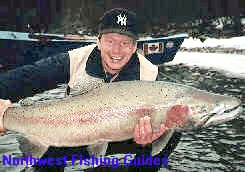 Our lodge record steelhead
weighed 32-pounds. It was caught and released by Dennis Therein
from the Kalum river in 1995. It measured 40 inches in length
and had a girth of 24.5 inches. The weight was estimated by using
a formula of length x girth squared x 1.33 divided by 1000.
Our lodge record steelhead
weighed 32-pounds. It was caught and released by Dennis Therein
from the Kalum river in 1995. It measured 40 inches in length
and had a girth of 24.5 inches. The weight was estimated by using
a formula of length x girth squared x 1.33 divided by 1000.